Due to their health benefits and delicious taste, apples are one of the most consumed fruits. This fruit is highly profitable due to its high consumption and medicinal value. The fruit can be grown in mild-temperature regions due to its temperate nature. However, the fruit requires a long period of dormancy, well-drained soil, and careful pruning for good growth. In addition to eating them fresh, apples can also be served in various ways, including salads, cakes, and puddings.
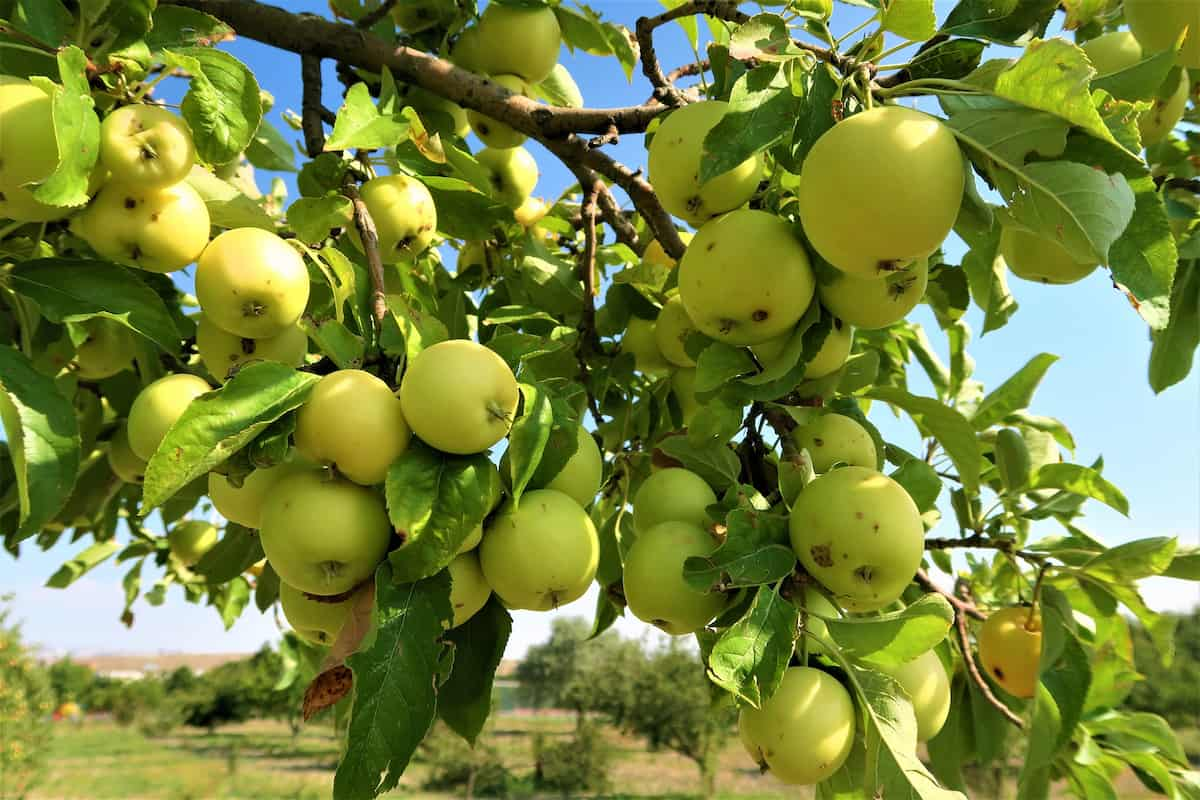
Among the apple varieties grown in India are Ambri Apples, McIntosh Apples, Granny Smiths, Honeycrisps, Chaubattia Anupams, Golden Delicious, Suneharis, Fuji apples, Tydeman’s Early and Red Delicious. Some apple varieties are grown in India, while others are imported. The purpose of this article is to discuss the cultivation of green apples.
How to start Green Apple farming in India
Green Apples (Granny smith apples)
- The green apple is a hybrid fruit. It is developed by combining two different species of apple, namely, Malus Sylvester and Malus Domestica.
- It contains bioactive compounds and flavonoids in a very good amount as compared to other varieties of apples.
- The green apple is a medium size, round conic to conic in shape and occasionally has indistinct ribbing on the face and is more pronounced at the crown. It is a crisp, hard apple with a sharp, acidic taste.
- The smooth, tough skin is characteristically bright green, sometimes with a purple-brown flush on the sun-exposed side, though the blush usually indicates that the apple has been grown in cooler climates.
- Green apple trees can grow up to 12-14 feet in height and around 14-16 feet in width.
- The tree grows between 13 and 24 inches per year and takes between 3 and 5 years to fully mature and bear fruit.
- The average weight of each green apple is 150 to 200 grams. The average yield per acre is 4.5 to 5 tons.
- Green apple takes time to bear fruit is depends on the type of Granny Smith apple tree. For example, a standard tree will take four to six years after grafting, while the Dwarf Granny Smith takes up to three years. On the other hand, semi-dwarfs start producing within three or four years.
Green Apple cultivating states in India
In India, green apple is primarily cultivated in Jammu & Kashmir, Himachal Pradesh, the hills of Uttar Pradesh, and Uttaranchal. However, it is also cultivated to a small extent in Arunachal Pradesh, Nagaland, Punjab, and Sikkim.
Green Apple varieties
| Granny Smith Apple | Smeralda Apple |
| Newtown Pippin Apple | Crispin |
| Rhode Island Greening Apple | Aurora Apple |
| Pound Sweet Apple | Antonovka Green Apple |
In case you missed it: Top Varieties of Bananas in India: Best List, Banan Types for Higher Profits, and Yield
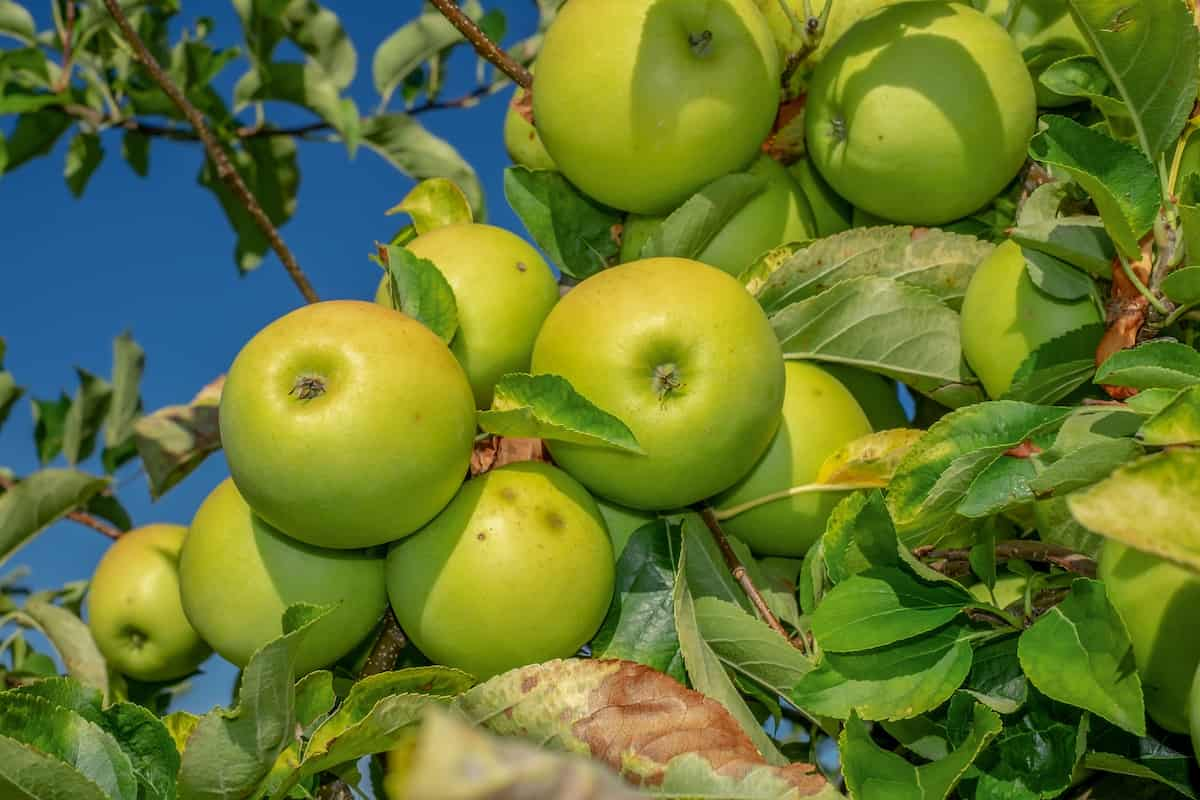
Climate requirements for Green apple cultivation
Green apple tree varieties thrive in a cold and wet climate, where a cold winter is followed by a cool spring and summer. Abundant sunlight is necessary, as it significantly affects the color of the fruit. Generally, the green apple tree has greater needs in the cold than most deciduous fruit trees. Most popular apple tree varieties thrive in regions where temperatures rarely exceed 32 °C. Many apple farmers also use big fans to cool the apple orchard when the temperature exceeds a certain point.
Soil for Green Apple cultivation
A green apple tree will thrive in a variety of soil types. However, Green apple trees prefer acidic soil. They dislike humidity, salty soils, and coastal conditions. Apples prefer a neutral soil pH between 5.5 – 7. Improve soils with decomposed compost before planting. You can dig up several cups of soil, let them dry out for a day or so, and perform a soil test using a kit, adding a test powder to a water chamber mixed with the soil and checking the color after 10 minutes. Follow the instructions carefully for an accurate reading. A pH of 7.0 indicates a neutral value. Values below 7.0 indicate acidic soil, and values above 7.0 are alkaline.
Land preparation for Green Apple cultivation
- Digging a hole of 25 inches (63cm) in diameter and 25 inches (63cm) in depth for every young apple tree we intend to plant.
- Add organic materials such as well-rotted manure or compost to the soil to increase macronutrient and micronutrient concentrations, drainage, and aeration.
- Stir 2 to 3 inches of organic matter into the dirt at 18 inches, the depth at which most apple trees begin to grow.
Green Apple tree planting
- Granny Smith can thrive in various soil types. First, add organic material such as compost to the soil to improve macronutrient and micronutrient concentrations. Then, stir 2-3 inches of the compost into the soil at a depth of between 18 and 20 inches.
- Now, it is time to choose the right sapling. It would be best to choose a seedling around 12 months old and 6 feet tall for ideal results.
- Once you have brought the sapling home, keep it in a cool area. Before planting, you should soak the sapling’s root ball in water for half an hour to help soften the roots.
- While the tree is soaking, dig a hole slightly larger than the sapling’s root ball.
- In the hole, place the tree and fill it up with soil.
- Three inches above the ground is the recommended height for attaching the scion.
- Adding fertilizer at that time is likely to hurt the young roots of the trees, so it should be avoided. We can instead irrigate and prune the young trees as soon as they are planted.
Plant-to-plant and row-to-row spacing in Green Apple cultivation
- The distance we leave between the apple trees depends on the apple cultivar and, more specifically, on the final size of the mature tree and our preference regarding extensive farming.
- The distances between rows and between trees in the row range from 22 X 16 feet to 6 X 6 feet (7m X 5m to 1.8m X 1.8 m). 22 X 16 feet pattern results in 124 trees per acre.
- 6 X 6 feet pattern results in 1210 trees per acre, or 3000 trees per hectare, which dwarf varieties can only achieve.
- In previous years, apple trees were spaced at an average of 20 X 20 feet (6 m x 6 m). This pattern gave 109 trees per acre, which took about 20 years to reach maximum production. However, nowadays, by using dwarf rootstocks, we can have about 800 per acre, and maximum production can be reached within 6-7 years.
In case you missed it: Banganapalli Mango Farming in India: A Guide to Planting, Care, Pests and Disease Management
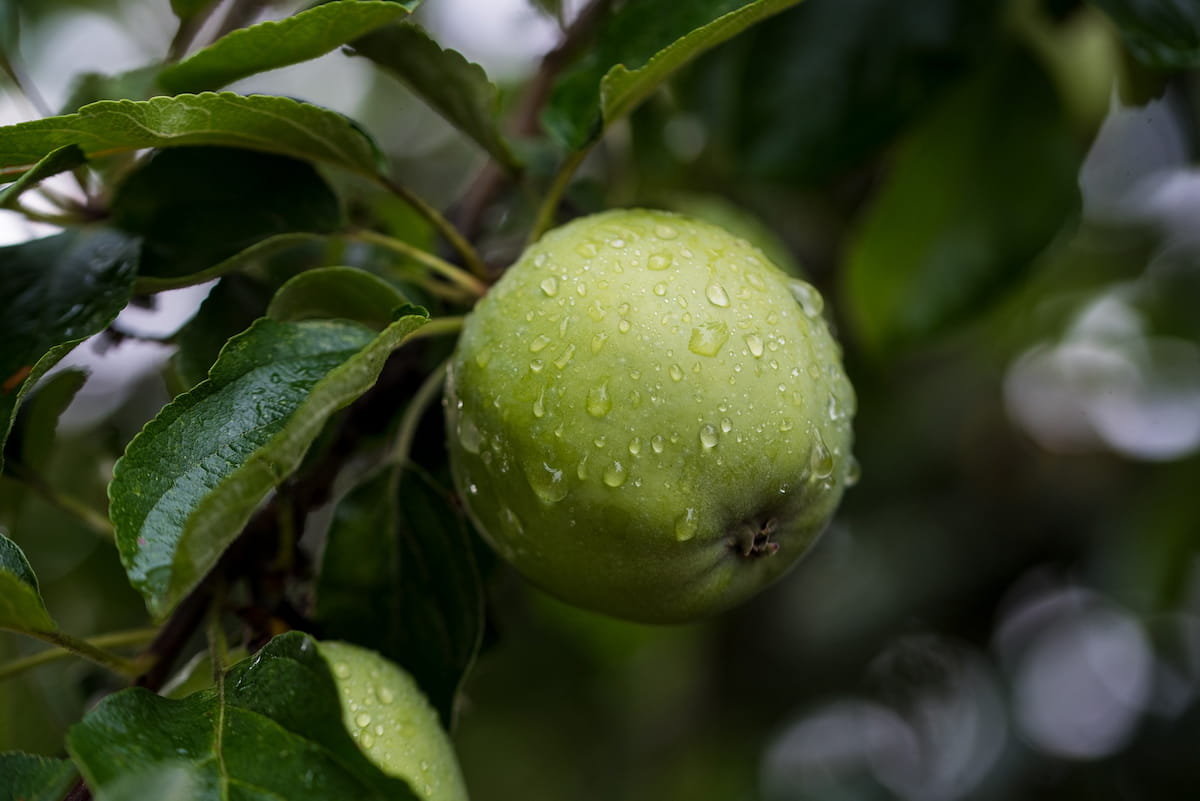
Green Apple crop care
Irrigation requirements for Green Apple cultivation
- The tree is considered newly established during the first year, meaning your plant must be watered. On light/sandy soil, water two times a week, but on clay soil, one time a week will do.
- When watering your tree, make sure the root system is completely soaked. Whether you use an automatic irrigation system or a watering can, you should water periodically and let the soil dry out between waterings.
- Fruit trees do not grow well in perpetually wet soil. It is equally harmful to overwaters as it is to underwater. Therefore, rainwater should always be considered before watering your tree by hand or irrigation.
- Once established, a tree should receive one inch of water per week. As the tree’s root system will have established itself after the first year, you won’t need to be quite as vigilant.
- Fruit trees require the most water just before, during, and just after the blossoming period, which lasts about six weeks, and just before harvest. Therefore, it is important to water regularly, especially during dry spells. The lack of rain or water during a dry spell can cause fruit to drop prematurely.
Green Apple tree fertilizer requirements
- Nitrogen and Potassium are important for leaf growth, flowering, and fruit set. At the same time, Phosphorus is crucial for developing a strong root system, especially at the early stages of plant development. Calcium, Magnesium, Manganese, Zinc, and Boron are also important for various stages of bud development, flowering and fruition. Any deficiency will negatively affect fruit number, quality, and general tree health.
- Mature fruit-bearing trees need more fertilization than young trees that have not entered their fruition period. For example, the average mature apple tree needs 270 g of N per year, while the average young non-bearing fruit needs only 68 g of N per year. These are the rates for standard-height trees, so the need for dwarf trees is normally decreased by 40%.
- A common fertilization scheme used by many apple growers is adding once a year, 0.5-2 kg of N-P-K 12-12-12 or 11-15-15 per young tree and 3-5 kg of N-P-K 12-12-12 or 11-15-15 per mature tree.
- Most soil fertilizers are applied from March to July. Especially if there is a Phosphorus deficiency, we may have to apply N-P-K 0-25-0. Remember that the 0-25-0 fertilizer must not come in contact with the tree roots.
- A second commonly used fertilization scheme in an average commercial apple orchard with 240 mature trees per acre is adding 45 kg N and 80 kg K20 per acre. In contrast, according to leaf analysis, Phosphorus, Magnesium, and Calcium fertilizers are added.
Pruning
Plant vigor and productivity are greatly enhanced by pruning. As a result of pruning, sap flow is diverted to fruiting branches, encouraging the plants to bear more fruit or produce vigorous vegetative growth. In addition, a tree’s weak-growing and diseased branches are removed during pruning. Every year, trees are pruned during December and January. Apple cultivation uses the following pruning systems.
Established spur system
This pruning aims to develop fruit spurs that permanently produce fruits. Therefore, it is important to cut back the central leader and erect laterals yearly to encourage spur production on the laterals. As a result, spurs are formed with wide-angled, strong laterals.
Regulated system
Regulated pruning is generally practiced on apple cultivars growing on semi-dwarfing and vigorous rootstocks. Before planting, the tree’s central leader is cut back at 75 cm, on which three well-placed primary branches are allowed to grow. Weak and crowded branches are pruned in bearing trees to encourage leadership and strong laterals.
Renewal system
In vigorous cultivars, instead of developing permanent spurs, the objective is to encourage the continuous growth of new healthy shoots, spurs, and branches every year. Each year, pruning a part of the tree produces fruit on the new shoot growth the following year, while unpruned parts produce fruit buds.
In case you missed it: Red Lady Taiwan Papaya Farming in India: How to Start, Yield, Care, and Management
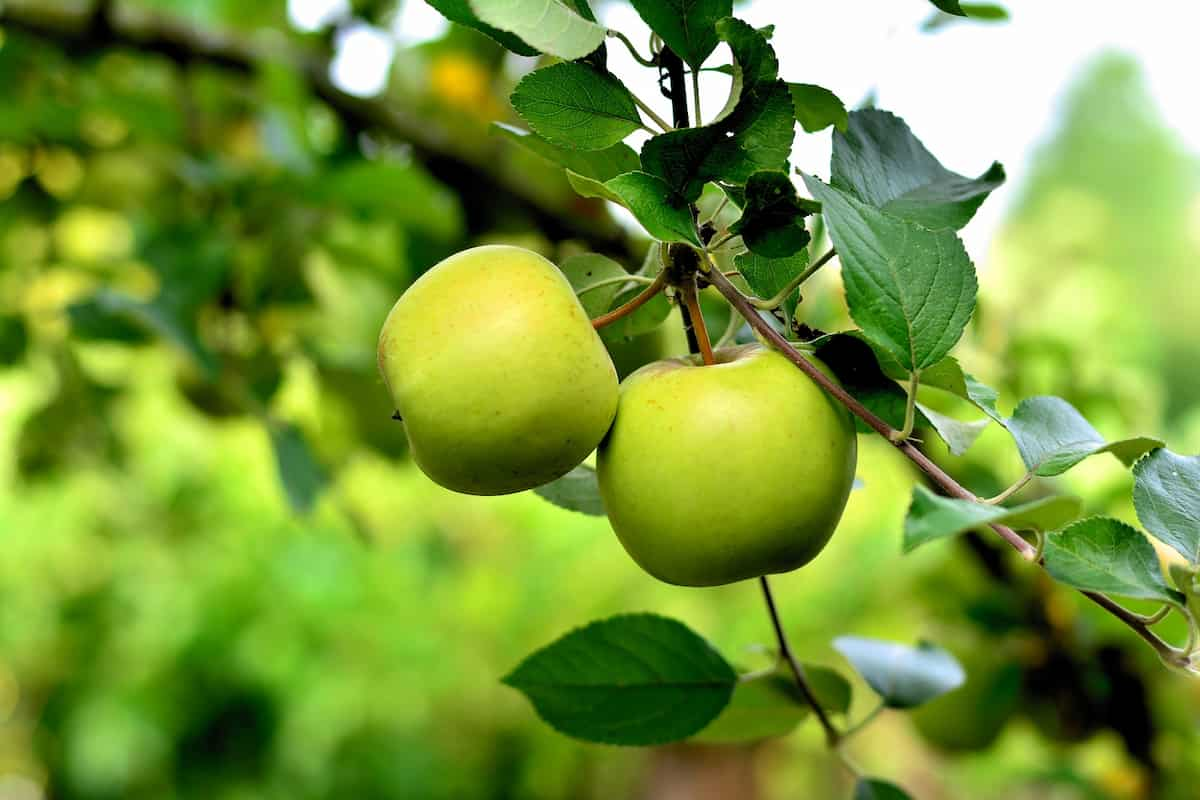
Thinning Apples
- Apples are often grown without any thinning other than what nature provides in the annual spring drop.
- However, to avoid potential disease and insect problems, it’s helpful to thin after the natural fruit drop (about 4 to 6 weeks after bloom) to one fruit per cluster or about 6 to 8 inches between fruit.
- It seems hard, but this practice evens production, prevents a heavy crop from breaking limbs, and ensures a better-tasting, larger fruit crop.
- Soon after fruit-set, remove the smallest or damaged fruits, leaving about four inches between those that remain.
Pests in Green Apple farming
Woolly aphid
Symptoms of damage
- Nymphs and adults suck the juice from the bark of the trunk or fruits
- Weakening and death of the smaller plants
- Infested twigs shrivel and die
- Galls on the roots
- White, woolly patches on the trunk.
Control methods
In spray mode, spray dimethoate 30 EC 0.06% or methyl demeton 25 EC 0.025%
San Jose scale
Damage symptoms
- A reddish-pink color appears in the infested area of the bark
- Purple discoloration on fruits is common.
- Young trees or branches with infested shoots lose their vigor and die
Control methods
- Ensure nursery stock is free of scale infestations
- HCN gas or methyl bromide can be used to fumigate nursery stock
- Spray phosalone 50 EC 0.05% or fenitrothion 50 EC 0.05% in the summer
- Spray each tree with 8-12 liters of diesel oil emulsion (4.5 liters of diesel oil, 1 liter soap, 54 liters of water).
In case you missed it: Honey Dew Papaya Farming in India: How to Start, Care, Pest, and Disease Management
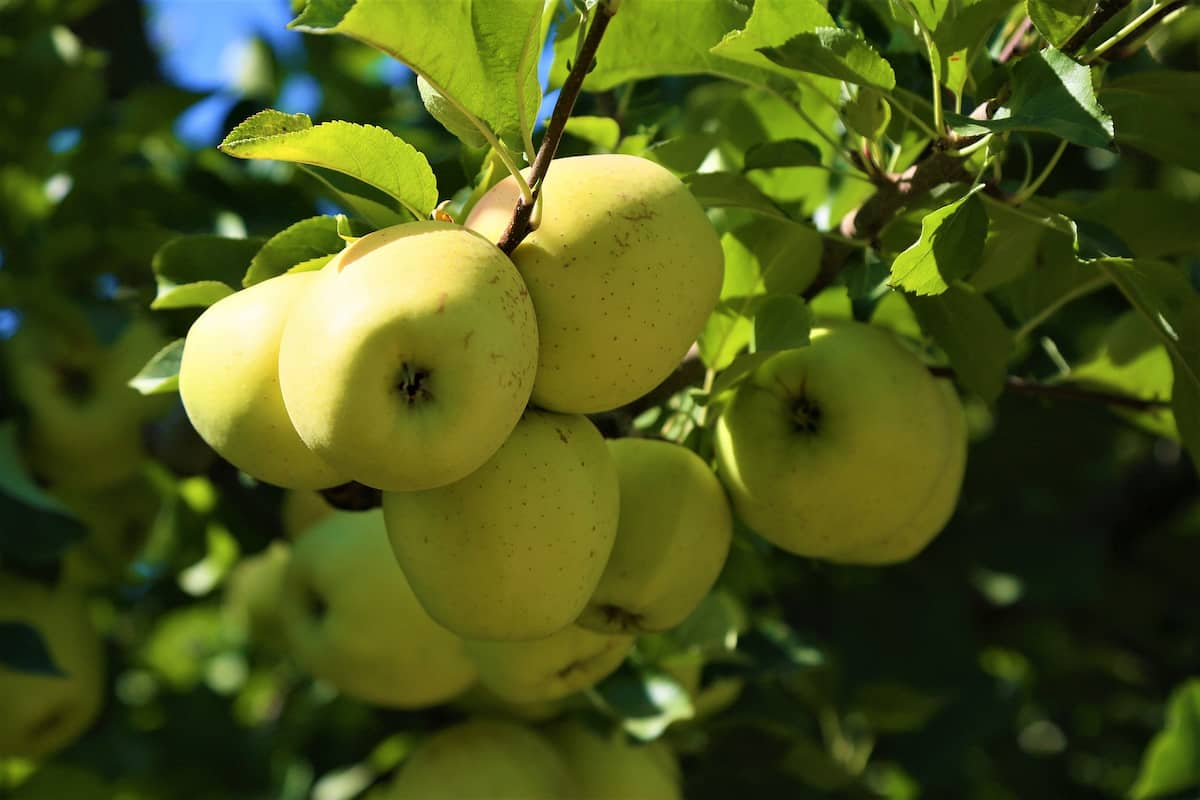
Codling moth
Damage symptoms
- The caterpillar feeds on the pulp of the fruits
- Frass tunnels can be seen on infested leaves and fruits
Control methods
- Mass trap males with codling moth lure traps
- Release egg parasitoids, Trichogramma embryophagum at 2000/tree
- Apply Virosoft CP4 Granulovirus
- Codling moth larvae must eat the virus before they enter the fruit
- Spray DDVP 0.04%
- Apply diazinon and acetempride (4 applications per season) during egg laying stage
Diseases of Apple
Marssonina leaf blotch
Disease symptoms
- Dark green circular patches appear on the upper surface of the leaf, resulting in 5-10 mm brown spots on the leaf, which eventually turn dark brown.
- As the leaf matures, it also develops on the lower surface.
- The leaf surface is covered with small black acervuli.
- It is common for numerous lesions to merge, resulting in large dark brown scars and yellowish surrounding areas.
Chemical control and management
- Reduce disease incidence with fungicides such as mancozeb, dodine, and trifloxystrobin.
- After harvesting, copper-oxychloride can be applied.
- For effective control, use fungicides such as dodine + hexaconazole, zineb + hexaconazole, and mancozeb + pyraclostrobin.
- Mancozeb (0.3%), copper oxychloride (0.3%), Zineb (0.3%), HM 34.25SL (0.25%), Dodine (0.075%), and Dithianon (0.05%) were used to control the disease in the field.
Black rot canker
Disease symptoms
- Leaf symptoms appear in the spring when the leaves are unfolding.
- There are small purple spots on the upper surface of the leaves that enlarge into circular lesions between 1/8 and 1/4 inch (3-6 mm) in diameter.
- Lesion margins remain purple, while lesions centers turn brown to tan.
- Infected leaves become chlorotic, and they defoliate.
- The flesh of the rotted area remains leathery and firm. Infected fruits often have black pycnidia on their surface.
- A wound in the bark is usually associated with lesions resulting in canker formation.
Chemical control
- Prune out cankers to greatly reduce the amount of available inoculum. Black rot can be controlled by starting a full-rate protectant spray program early in the season with copper-based products, lime-sulfur, or Daconil.
- In commercial settings, apply one ethylene bisdithiocarbamate (EBDC) fungicide (Polyram, Manzate, and Dithane). After petal fall, Captan at full rate, or a combination of Benlate and Captan, often used for powdery mildew control, will also provide black rot control.
In case you missed it: Totapuri Mango Farming in India: A Complete Cultivation Guide to Planting to Harvesting
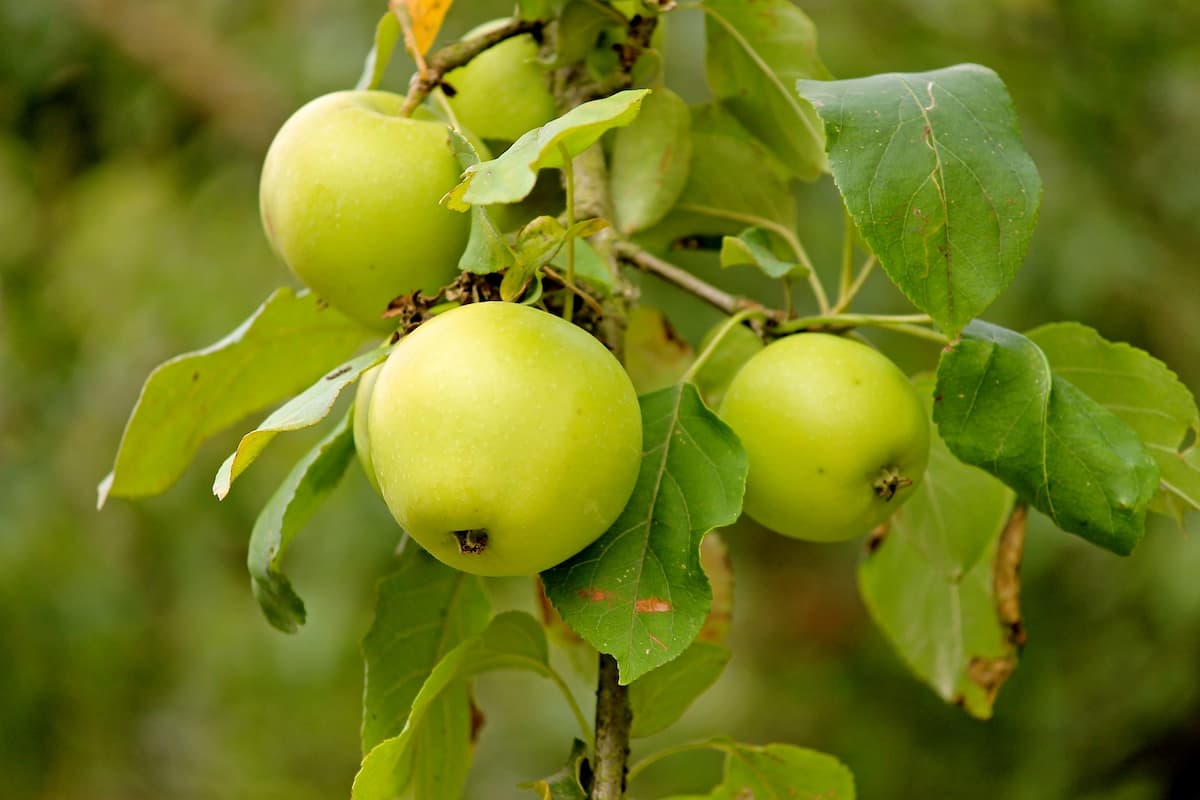
Marssonina leaf blotch
Disease symptoms
- Dark green circular patches on the leaf’s upper surface give rise to 5-10 mm brown spots that become dark brown in due course.
- As the leaf matures, it also develops on the lower surface.
- The leaf surface is covered with small black acervuli.
Chemical control
Several fungicides control Marssonina blotch of apples, including trifloxystrobin, kresoxim-methyl, difenoconazole, cyprodinil, myclobutanil thiophanate-methyl, and mancozeb.
Green Apple harvesting
September-October month is the best time for the harvesting of apple season. Appletree starts taking effect from the 8th year onwards. And the productivity of apples increases from the 8th to the 17th year; after that, the product remains stable for 30 years. The life of an apple tree extends up to 40 years, but it depends on the area’s climate condition. Farmers harvest apple fruits before they are fully ripe.
Conclusion
This variety is the perfect apple for all your favorite apple treats, from caramel apples to apple pies. This apple tree blossoms in spring with beautiful white blossoms. Green apples were first cultivated by an Australian woman named Maria Smith; hence they are also known as Granny Smith apples. Granny Smith apples are the most popular green apple variety in the world.
- How to Build a Low-budget Goat Shed: Cheap Ideas and Tips
- Goat Farming Training Programs in India: A Beginner’s Guide
- Types of Pesticides Used in Agriculture: A Beginner’s Guide
- Economical Aquaculture: A Guide to Low-Budget Fish Farming
- 15 Common Planting Errors That Can Doom Your Fruit Trees
- How to Make Houseplants Bushy: Effective Tips and Ideas
- Innovative Strategies for Boosting Coconut Pollination and Yield
- Pollination Strategies for Maximum Pumpkin Yield
- The Complete Guide to Chicken Fattening: Strategies for Maximum Growth
- Natural Solutions for Tulip Problems: 100% Effective Remedies for Leaf and Bulb-Related Issues
- Revolutionizing Citrus Preservation: Towards a Healthier, Greener Future
- Natural Solutions for Peony Leaf and Flower Problems: 100% Effective Remedies
- Maximizing Profits with Avocado Contract Farming in India: A Comprehensive Guide
- Natural Solutions for Hydrangea Problems: 100% Effective Remedies for Leaf and Flowers
- The Ultimate Guide to Choosing the Perfect Foliage Friend: Bringing Life Indoors
- From Sunlight to Sustainability: 15 Ways to Use Solar Technology in Agriculture
- The Ultimate Guide to Dong Tao Chicken: Exploring from History to Raising
- The Eco-Friendly Makeover: How to Convert Your Unused Swimming Pool into a Fish Pond
- Mastering the Art of Delaware Chicken Farming: Essentials for Healthy Backyard Flocks
- 20 Best Homemade Fertilizers for Money Plant: DIY Recipes and Application Methods
- How to Craft a Comprehensive Free-Range Chicken Farming Business Plan
- Brighten Your Flock: Raising Easter Egger Chickens for Beauty and Bounty
- How to Optimize Your Poultry Egg Farm Business Plan with These Strategies
- Subsidy for Spirulina Cultivation: How Indian Government Schemes Encouraging Spirulina Farmers
- Ultimate Guide to Raising Dominique Chickens: Breeding, Feeding, Egg-Production, and Care
- Mastering the Art of Raising Jersey Giant Chickens: Care, Feeding, and More
- Ultimate Guide to Raising Legbar Chickens: Breeding, Farming Practices, Diet, Egg-Production
- How to Raise Welsummer Chickens: A Comprehensive Guide for Beginners
- How to Protect Indoor Plants in Winter: A Comprehensive Guide
- Ultimate Guide to Grow Bag Gardening: Tips, Tricks, and Planting Ideas for Urban Gardeners
- Guide to Lotus Cultivation: How to Propagate, Plant, Grow, Care, Cost, and Profit
- Agriculture Drone Subsidy Scheme: Government Kisan Subsidy, License, and How to Apply Online
- Ultimate Guide to Raising Araucana Chickens: Breed Profile, Farming Economics, Diet, and Care
- Bringing Hydroponics to Classroom: Importance, Benefits of Learning for School Students
- Ultimate Guide to Raising Polish Chickens: Breed Profile, Farming Economics, Diet, and Care
- Ultimate Guide to Raising Australorp Chickens: Profile, Farming Economics, Egg Production, Diet, and Care